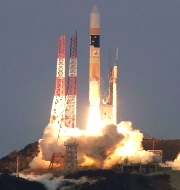ISRO launches two satellites NovaSAR and S1-4 using PSLV-C42
Indian Space Research Organisation (ISRO) successfully launched two satellites— NovaSAR and S1-4-belonging to United Kingdom (UK) based Surrey Satellite Technology Limited (SSTL). Both satellites were injected into Sun Synchronous Orbit (pole-to-pole orbit) at an altitude of 583 km after the launch.
About launch
These satellites were launched on board of Polar Satellite Launch Vehicle (PSLV-C42) from first launch pad of Satish Dhawan Space Centre (SDSC) SHAR, Sriharikota, Andhra Pradesh. This was the 44th flight of PSLV and the 12th flight of Core Alone version of the vehicle.Core Alone version of PSLV is lightest version without six strap-on motors. It is used for launching smaller payloads. It was ISRO’s first fully commercial trip of the year. This launch helped Antrix Corporation, commercial arm of ISRO to earn more than Rs. 220 crore. As on date, ISRO has launched 239 foreign satellites of 28 countries.
Key Facts
S1-4 Satellite: It is high resolution earth observation satellite meant for surveying resources, environment monitoring, urban management and disaster monitoring.
NovaSAR Sateillite: It carries S-band Synthetic Aperture Radar (SAR) and Automatic Identification Receiver payloads. It is technology demonstration mission designed to test capabilities of new low cost S-band SAR platform. Its applications include forestry mapping, land use and ice cover monitoring, flood and disaster monitoring and maritime missions. It will be operated from SSTL’s Spacecraft Operations Centre in Guildford, UK.
PSLV
PSLV is the third generation launch vehicle of India, designed and developed by ISRO’s Vikram Sarabhai Space Centre, Thiruvananthapuram. It is hailed as the reliable and versatile workhorse launch vehicle of India. It consists of four stages, using solid and liquid propulsion systems alternately. Each stage of PSLV is self-contained vehicle capable of functioning independently with own propulsion systems.
It is capable of launching 1600 kg satellites in 620 km sun-synchronous polar orbit and 1050 ks satellite in geo-synchronous transfer orbit. There are three variants of PSLV, namely, PSLV-G, PSLV-CA, PSLV-XL. In the standard configuration, it measures 44.4 m tall, with a lift off weigh of 295 tonnes.
Some notable payloads launched by PSLV include India’s first lunar probe Chandrayaan-1, India’s first interplanetary mission, Mars Orbiter Mission (Mangalyaan) and India’s first space observatory, Astrosat.
Month: Current Affairs - September, 2018


